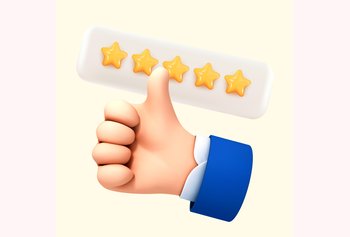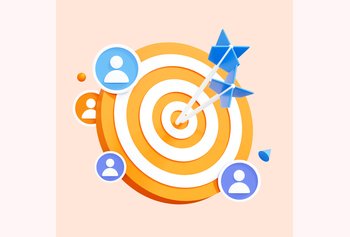Top 19 Zendesk Alternatives for 2025

Table of contents
If you’ve researched customer support tools, you would’ve definitely heard of Zendesk. There are many businesses that use Zendesk to offer support via voice, live chat, email, messaging, social channels, and other touchpoints.
But before signing up for their free trial, keep in mind that Zendesk is like creating a complicated LEGO set. You and your team will be required to invest a lot of time, patience, and money to build it to your liking.
While it’s a popular solution, it may not be the most viable option for your business. Zendesk competitors offer similar features that are not only more user-friendly but also budget-friendly.
Table of Contents
- Why should you consider an alternative to Zendesk?
- 19 Best Zendesk Alternatives in 2025
- How to select a helpdesk software that works for your business?
Why should you consider an alternative to Zendesk?
Here are a few reasons why you should look out for an alternative option to Zendesk.
- Complexity – Zendesk is popular for its robustness and extensive feature set but owing to this, the tool gets complicated to use and overwhelming for a lot of its users. There is a steep learning curve that you can only get through with their private training sessions which can cost you anywhere from $1500-2800. This also increases the time your support staff will take to get set-up and start using the software. In fact, one user on Reddit explained:-
“It took me 3 to 4 weeks to learn Zendesk. Then another couple of weeks to meet with the various department leaders to help refine their processes and design workflows. It took me 3 weeks to build the whole thing out in the production environment and test everything. Then we spent a week migrating our tickets over from the old system and training all the agents.”
- Steep pricing – Another issue is Zendesk’s pricing. It’s quite complicated to comprehend and for most companies, expensive.Their plans are expensive enough on their own but when you lug in training costs, add-on fees, and other hidden costs you’ll more often than not be taken by surprise at how much you’re paying for the software.
I’ll explore this more in the next section but essentially their pricing tiers are complex and muddled so it’s hard to figure out what plan is best suited for you. A consequence of this is you end up opting for a plan you don’t necessarily need and pay through the nose. - Limited support – Zendesk also offers limited support to its users. You don’t get 24×7 support on any of their pricing plans. Instead, you’ll need to purchase their ‘premier add-on’ to get support outside of business hours which starts at $6000 as a one-time fee.
Zendesk’s users also aren’t very happy with the quality of support they receive. One user said this on Reddit –
“Quit limiting the way we can contact support. It’s really annoying to spend almost 60K a year on Zendesk, and not be able to call.”
Let’s explore 19 alternatives to Zendesk that could better fit your team’s requirements and help you deliver amazing customer support.
19 Best Zendesk Alternatives in 2025
1. Hiver
A good customer service tool should be simple to use and offer features that your support team can quickly adopt. It should be able to handle scale and offer impeccable vendor support. These are some non-negotiables.
Hiver checks all those boxes and much more. It helps teams assign, track, and collaborate on customer queries, as well as run the most advanced analytics and automation right from Gmail and Outlook. Over 10,000+ teams use Hiver because they really appreciate the fact that they don’t have to learn a new, complicated system. They can manage customer support from their familiar email interface.
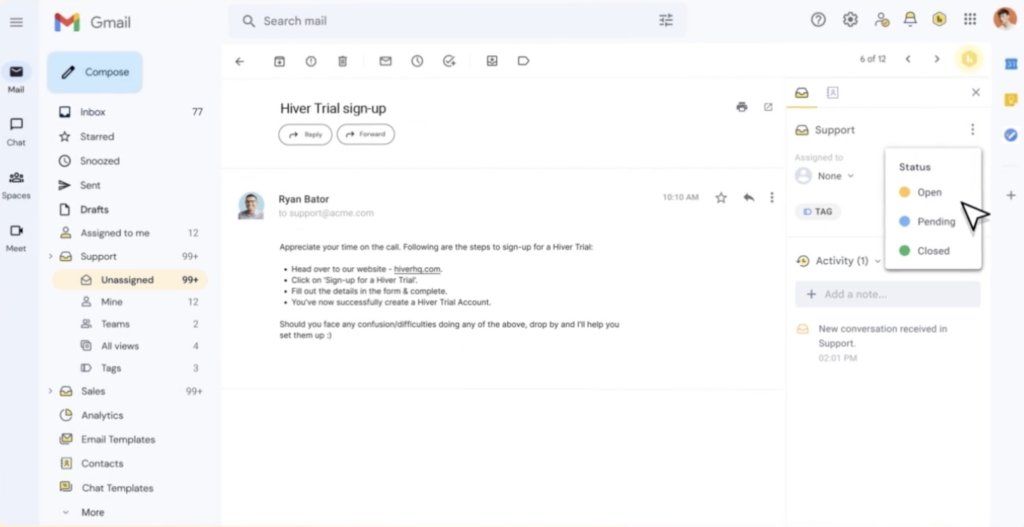
Now that you have a fundamental understanding of why Hiver has the edge over Zendesk, let’s dive in a little deeper.
Hiver is a lot more cost-effective than Zendesk
First off, let’s look at the difference in price you’ll incur with Zendesk and with Hiver for the most critical help desk features (think shared inboxes, live chat, knowledge base, automation, SLAs etc.).
| Software | Small+Medium Teams(10 users) | Large Teams(50 users) |
|---|---|---|
| Zendesk | $10,680 per year | $54,400 per year |
| Hiver | $5880 per year | $29,400 per year |
| Annual Savings | 45% per year |
As you can see, you get more bang for your buck with Hiver. With Zendesk, most of the advanced features you could want (eg: support outside of business hours) can only be bought as add-ons to your existing plans which makes it more expensive.
The 9 different pricing tiers that Zendesk offers – including their multiple add-ons and hidden expenses like training costs – make it very difficult to figure out which plan is best for your business. And because of this, you’ll more than likely be overpaying for features you don’t even need.
Compare this to Hiver – a support platform that offers four straightforward pricing plans – including a free-forever plan. No expensive training fee or add-on costs. No hidden fees.
There’s something for everyone – from support teams on a very tight budget to enterprises that want advanced AI support features .
You can get set-up in minutes with Hiver
Hiver sits inside your inbox (Outlook or Gmail) which is great because you’re essentially working within your email interface.
This makes it extremely intuitive and easy to get started with, unlike other solutions like Zendesk where you’re forced to learn a new interface from scratch. You’ll get all of Hiver’s functionalities on one single tab, so you won’t be constantly switching between tabs to get things done.
Zendesk, on the other hand, is notorious for having a complicated and lengthy set-up. Its robustness makes the UI overwhelming for users who inevitably require extensive training just to get started with the tool.
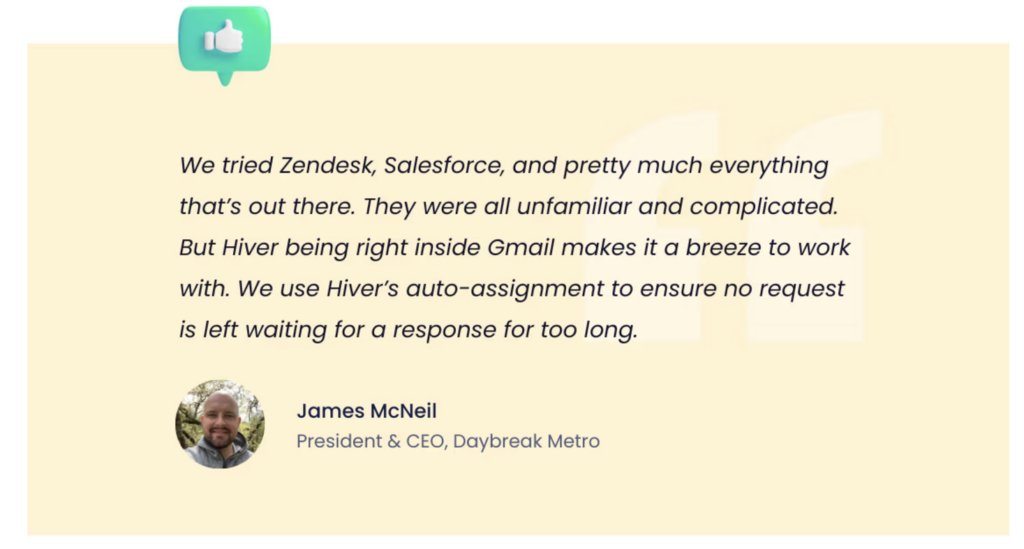
Hiver helps you humanize customer conversations and build relationships
The problem with Zendesk’s platform is that their email formatting is very impersonal, and customers feel like they’re talking to a robot. There’s the annoying “//Please reply above this line//” message that appears in emails sent from Zendesk, making communication very robotic.
This is important because customers today want empathetic interactions. Autoresponders like these sound impersonal and unfriendly to your customers.

With Hiver, you can create personalized conversations with customers. Here’s how:
- All replies go out from your support staff’s email ID. Not from the generic support@ or help@ email.
- Customers know there’s a living, caring human who’s helping them out with their query.
- Using the customer’s name conveys that you see them as a person with an identity rather than just a ticket number.
Access to 24×7 Support for Free
Another area where Hiver is significantly better than Zendesk is in vendor support – the assistance that the software provider offers to their users. With Zendesk:
- It’s very difficult to connect to a live agent. And if you do, they take forever to respond.
- You’ll be stuck in a rabbit hole of knowledge-base articles trying to figure out how to set up the tool.
- You have to upgrade to their “premier plan” to access 24×7 support.
With Hiver:
- You can connect to trained agents immediately
- You have access to 24×7 support for free, irrespective of your pricing plan.
- You get instant answers on its knowledge base
And we’ve got the numbers to back this up. Our first call resolution rate is 88%, exceeding the industry average of 40%. Our average chat response time is 13 seconds, nearly 3x faster than the industry average of 45 seconds, and we have a 95% CSAT score, ahead of an industry average of 92%.
2. Freshdesk
Freshdesk is a cheaper and simpler version of what Zendesk offers. It’s a capable digital customer support tool that provides a central, unified platform for businesses to manage customer interactions across multiple channels.
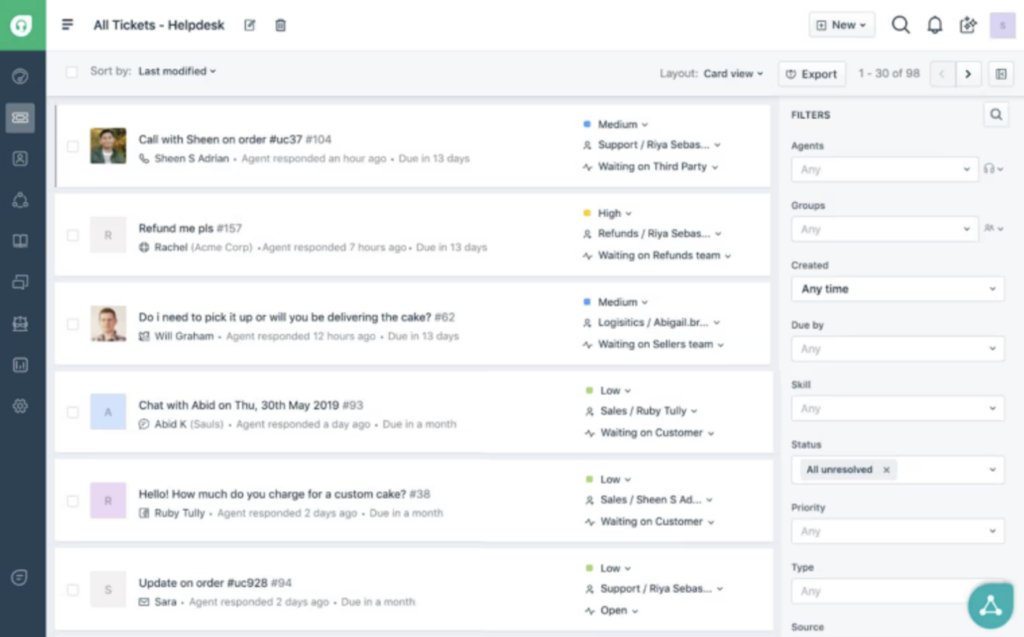
Key features
- Multi-Channel Support: Freshdesk enables businesses to manage customer interactions across various channels, including email, phone, live chat andsocial media. This multi-channel capability ensures that all customer inquiries are captured and addressed from a single interface.
- Customizability: Freshdesk is highly customizable, allowing businesses to tailor the platform to their specific needs. From custom ticket fields and workflows to personalized customer portals, Freshdesk can be adapted to fit different industries and service models.
- Freddy Self Service: Freshdesk’s AI bot, Freddy, can help you deploy an intelligent chatbot can help you deploy an intelligent bot to answer customer queries 24×7. This takes away a chunk of workload from your agents who can now focus on higher-value tasks or queries that need their inputs.
Reviews
I noticed a pattern of positive reviews on Freshdesk’s analytics capabilities. One Freshdesk user said this on G2:
“Easy access to daily, weekly, monthly reports and databases through this I am able to track the performances of the agents.”
However, a concerning pattern I noticed was that several of it’s users complained about how the tool gets noticeably slower when dealing with a higher volume of tickets. Here’s one of them: “Platform can regularly be on the slower side, particularly when dealing with high ticket or multiple number of workflows. This can cause a reduction in the general efficiency of the support process at some times.”
Pricing
Freshdesk has a forever free plan (up to two agents) with very basic functionality. Their paid plans start from $15 per seat per month.
Free trial: 14 days.
3. Intercom
Intercom is a customer communication platform designed to help businesses of various sizes offer prompt multi-channel support. It offers tools like an AI bot named “Fin” for instant support, a unified workspace for managing customer interactions, and proactive messaging features.
The platform also integrates with various channels, such as email and SMS, to provide diverse ways of supporting customers.
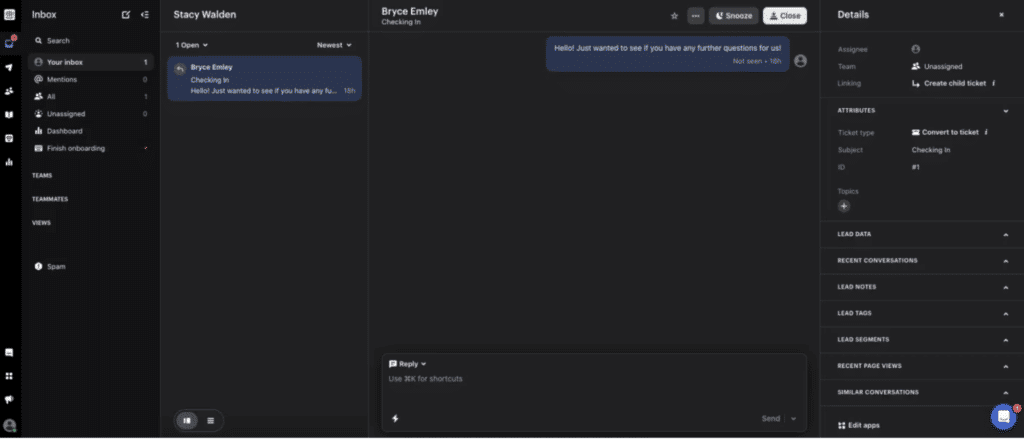
Key features
- Proactive Support: With advanced targeting and automation, Intercom enables businesses to send proactive messages based on user behavior or journey stage. For example, you can trigger a helpful message to guide users when they seem stuck on your website or app.
- Integrated Knowledge Base: Intercom’s help center is directly accessible within the chat widget, enabling customers to find answers independently. This self-serve option reduces response time while empowering customers to resolve issues on their own.
- Fin AI: Intercom’s advanced AI tool, Fin, uses deep learning to instantly generate accurate and context-aware responses to customer queries. Fin seamlessly integrates with your knowledge base to provide human-like, 24/7 customer support while reducing the load on your support team.
Reviews
“We’ve been using Intercom and Fin, and it’s been a lifesaver! Fin has been great at sorting through all the junk and flagging the real issues that only humans can handle. Plus, it was super easy to set up, and the Intercom support team has been awesome whenever we’ve run into any problems.” – Intercom user on G2.
“One small area for improvement is the search functionality. Occasionally, the results are a bit confusing, as the chats are not always sorted properly by date, which can make finding the correct conversation harder. It would be great to see this refined in future updates.” – Intercom user on G2.
Pricing
Intercom’s plans start from $29 per user per month. Fin AI is billed separately, it’ll cost you $0.99 per query it resolves.
Free trial: 14 days
4. Help Scout
Help Scout is a cloud-based customer service software that helps businesses offer personalized support to their customers at scale.
It has a simple interface that makes it easy for support teams to manage customer interactions across various channels, including email and chat. Let’s look at some of the key features this software offers.
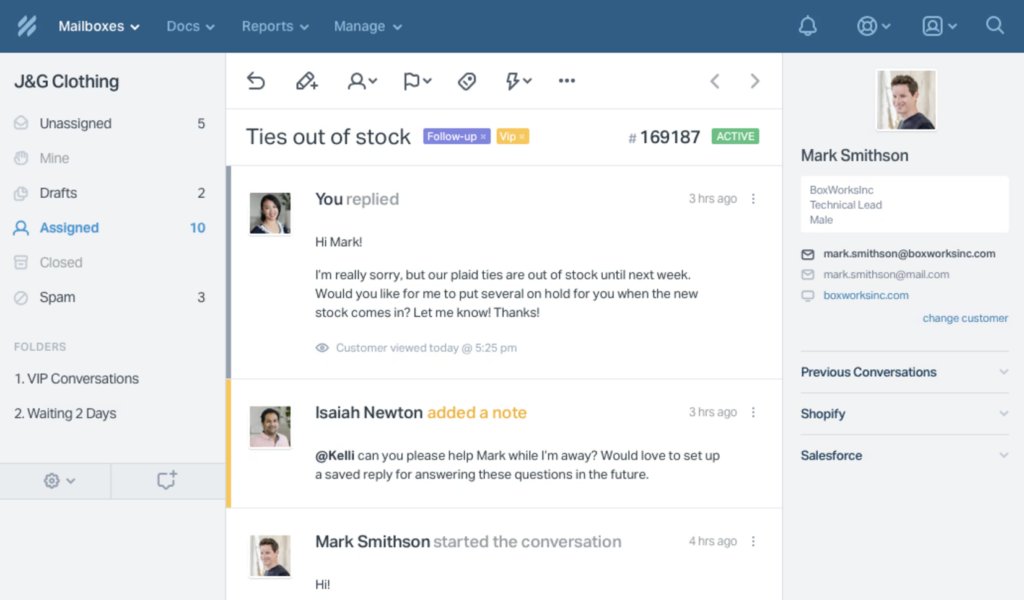
Key features
- Shared Inbox: The shared inbox feature allows teams to manage customer emails collaboratively. It ensures that no inquiries slip through the cracks and that multiple team members can work together on complex issues.
- Knowledge Base: Help Scout’s Docs feature allows businesses to create a knowledge base where customers can find answers to common questions on their own, reducing the number of support tickets.
- AI Summarizer: Help Scout also offers an AI summarizer feature that distills long emails and threads into simple, bullet points. This eliminates the need to read the entire thread to figure out what’s going on and what the next steps should be.
Reviews
Help Scout’s users speak highly of the platform’s interface. One user says: “The interface is clean, direct, and getting used to the layout is quick.”
But as is sometimes the case with products that have a simple interface, Help Scout is also limited in terms of its feature offerings. For example, one user points out: “There is only one knowledgebase template/design is available, it will be great if we have different templates to choose from.”
Pricing
Help Scout’s plans start from $22 per seat per month.
Free trial: 15 days.
5. GrooveHQ
GrooveHQ is the go-to solution for small to medium-sized businesses in need of efficient and budget-friendly cloud-based help desk software. The majority of businesses use Groove for one simple reason: seamless communication with customers through email, live chat, social media, and good old phone calls.
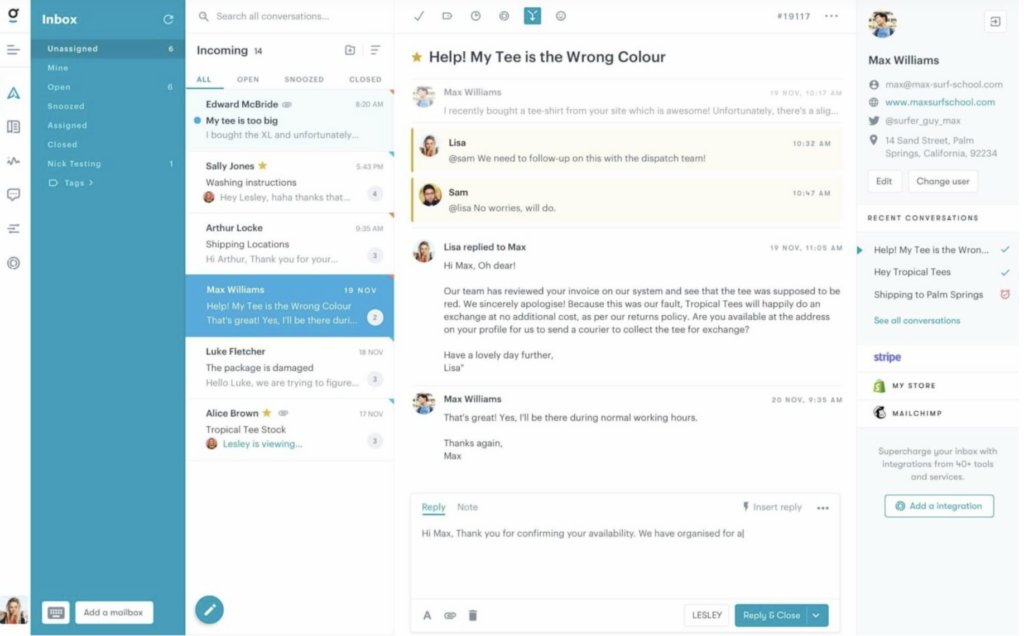
Key features
- Shared Inbox: GrooveHQ offers a unified inbox that consolidates customer communications from various channels, such as email and social media. This centralized system allows support teams to manage, assign, and track conversations efficiently, ensuring no customer query is overlooked.
- Automation and Rules: GrooveHQ allows users to automate repetitive tasks through customizable rules. Support teams can set up triggers and actions to streamline workflows, such as auto-assigning tickets, sending instant replies, or tagging conversations based on specific criteria.
- Integrations: GrooveHQ integrates with various third-party applications like Slack, Stripe, Shopify, and more. These integrations allow support teams to access relevant customer information and perform actions directly within the GrooveHQ interface, enhancing efficiency and collaboration.
Reviews
Groove’s customer support team is on top of any troubles or requests you might have. A user praised their efficiency in accommodating a new feature request: “There was a cosmetic feature lacking from their software but after a quick chat with their customer support, they added the feature we were missing within a week!”
Here’s one capability they lack as of right now though, according to another Groove user: “Groove lacks the capacity to export the data analytics provided in the report’s dashboard. This would be SUPER beneficial going forward!”
Pricing
GrooveHQ’s pricing starts at $16 per user per month. You can avail a 7-day free trial.
6. Zoho Desk
Zoho Desk is another digital customer service tool built to help businesses deliver exceptional service to their customers. It’s a part of the larger Zoho ecosystem, which allows for seamless integration with other Zoho applications and makes it a versatile tool for businesses of all sizes.
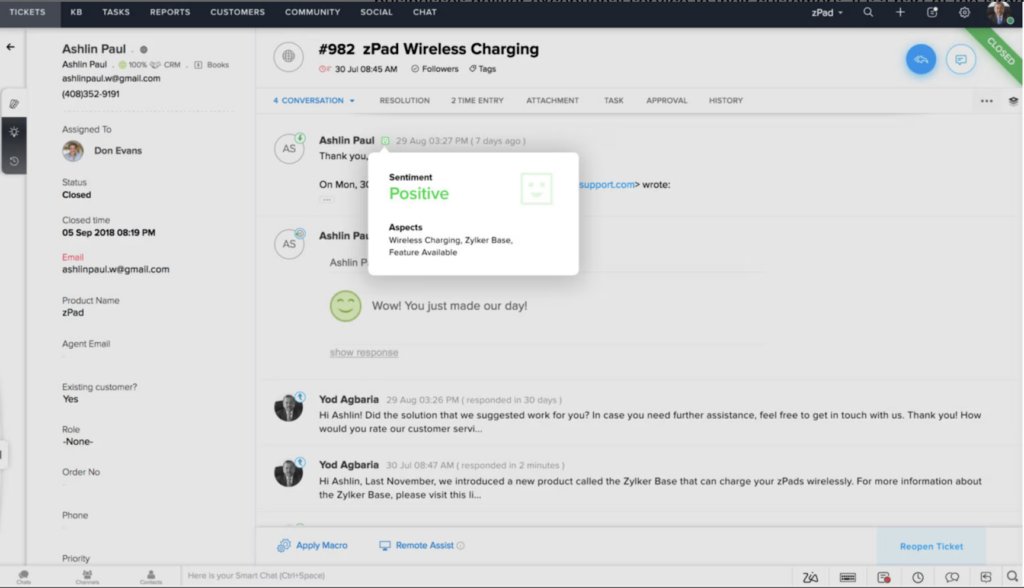
Key features
- Context-Aware Support: The platform provides detailed customer history and context for each interaction, enabling agents to deliver personalized and informed responses.
- AI-Powered Automation: Zoho Desk features Zia, an AI assistant that automates routine tasks, suggests solutions, and detects customer sentiment, allowing support teams to focus on more complex issues and operate more efficiently.
- Customizable Workflows: It offers extensive customization options, including the ability to create custom workflows, ticket layouts, and multi-department support setups, allowing businesses to tailor the platform to their unique needs.
Reviews
“The integration with other Zoho products has also been seamless, which is a great advantage for managing multiple business functions in one ecosystem.” (Zoho Desk user on G2)
Zoho Desk’s reporting capabilities have a little room for improvement. One user says: “One thing that may be improved with Zoho Desk is the reporting capabilities. I need to export data to external programs to gain a full picture of my customer service performance because the present reporting options are inadequate.”
Pricing
Zoho Desk has a forever free plan with limited functionality. Its paid plans start from $7 per seat per month.
Free trial: 15 days
7. Hubspot Service Hub
HubSpot Service Hub is a customer service platform designed to help businesses enhance customer interactions and streamline support operations. It integrates seamlessly with HubSpot’s CRM, and provides a unified view of customer data which can then be used to deliver personalized and efficient customer experiences.
In case you’re already using HubSpot’s CRM, then opting for Service Hub is a good decision.
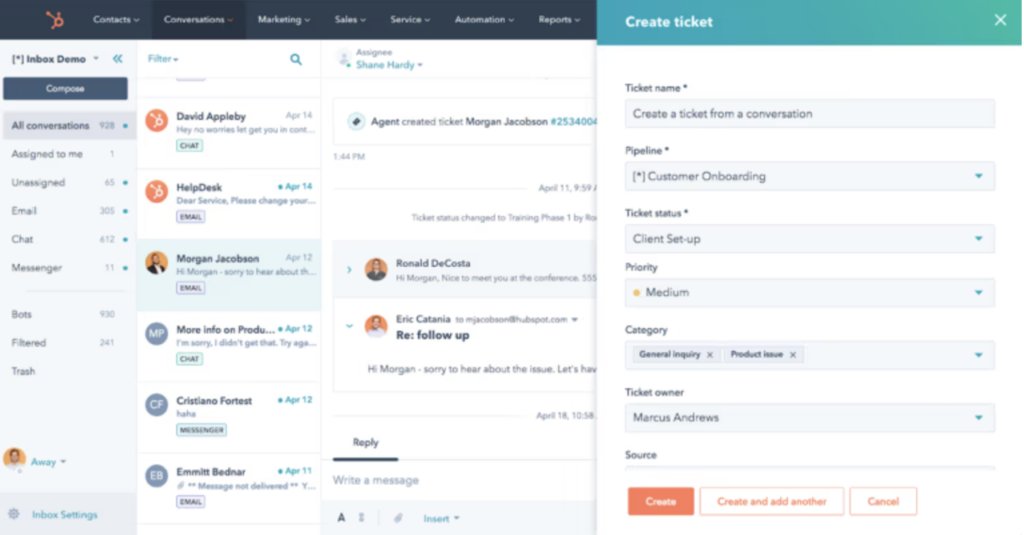
Key features
- Customer portal: A dedicated space for customers where they can easily access knowledge base articles, FAQs, and other resources. It can be deployed on your website or mobile application to help customers troubleshoot common issues on their own. Customers can even raise tickets if they are not able to find answers.
- Omnichannel messaging: Provide a unified experience for your customers across channels such as phone, live chat, email, and social media. This ensures that customers can switch between channels without losing the context of their conversation with your support team.
- Shared inbox: A free shared inbox that unifies conversations from live chat, Facebook Messenger, team emails, and chatbots. Teams can view and reply to conversations assigned to them via intelligent routing. This way every customer query receives a response.
Reviews
“I’d like to include dedicated ticket numbers in the subject of all incoming tickets. This would make tracking easier than the current system, where we have to search on the contact card or within tickets. It would also help distinguish multiple conversations with the same customer. This way of working can sometimes be confusing for our customer support team.” (HubSpot Service Hub User on G2)
“I want to commend the customer support team for their exceptional service. Whenever I call in with an issue, the hold times are remarkably reasonable. The support team consistently takes the necessary time to ensure my issues are fully resolved, and I never feel rushed during our interactions.” (HubSpot Service Hub User on G2)
Pricing
HubSpot Service Hub’s pricing starts at $450 per month and goes up to $1200 per month. You can also sign up for a free 14 day trial.
8. Gladly
Gladly is an AI-powered customer service platform designed to enhance customer interactions by focusing on people rather than tickets. What I mean by that is, Gladly facilitates better personalization of customer conversations. You can see the entire conversation history and preferences of each customer.
It’s primarily aimed at B2C businesses that want to provide more human and personalized customer service. Voice, IVR, self-service, text, chat, in-app chat support, social, and email are natively built inside Gladly.
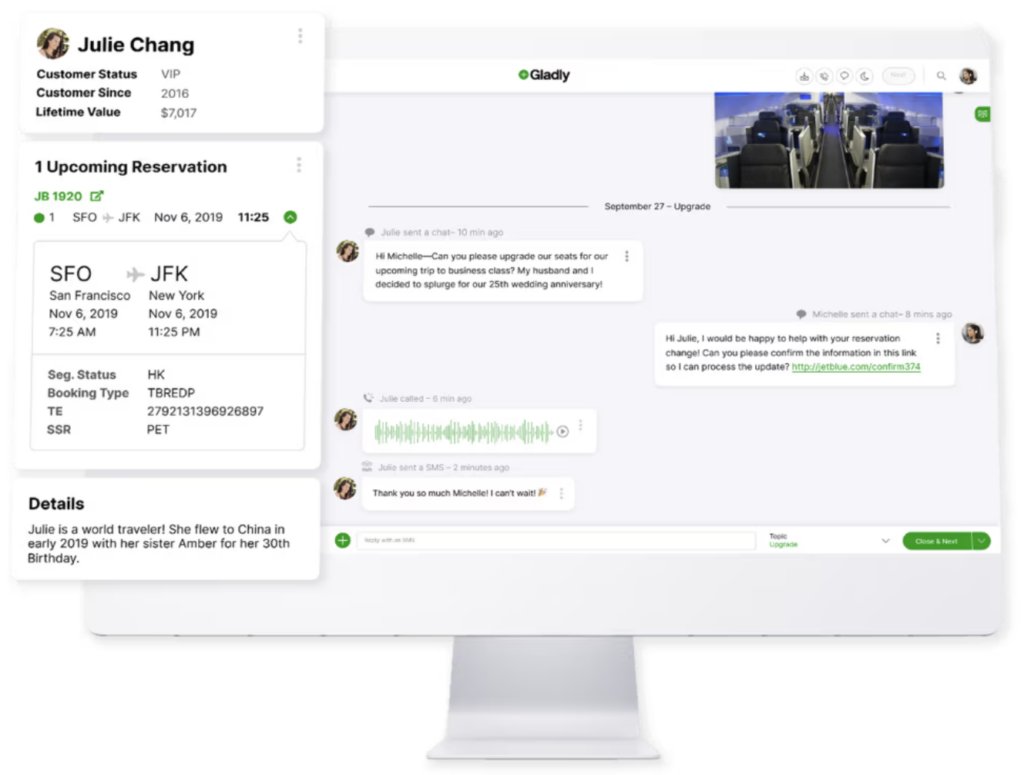
Key features
- People Match Routing: Intelligently routes customers to the most suitable agents based on factors like customer status, issue type, or language preference, ensuring personalized and effective support.
- Integrated Knowledge Base: Offers a centralized repository of information accessible to both customers and agents, facilitating self-service options and ensuring consistent, accurate responses across all channels.
- AI-Powered Assistance: Utilizes artificial intelligence to automate responses to common inquiries, suggest relevant answers, and assist agents in delivering faster resolutions.
Reviews
Gladly has a clean, simple interface. Here’s what a user on G2 has to say about it: “I like how simple and modern the interface is. My company has a few older folks that were used to using Five9 for years and when we switched to Gladly they were hesitant that they would be able to learn it, but the UI makes the switch over so much easier than we expected.”
However, there are some small tweaks they’d prefer that would make the experience even smoother. For example here are a couple reviews that talk about the way new notifications come in.
“When you have a chat or call come in, the banner blocks the options to go unavailable for calls and chats unless you decline the conversation.” (Gladly User on G2)
“I do not like the notifications that come across the top of the screen when you click next to get a new inquiry, it blocks the inquiry information that I am currently working on and is annoying. That is pretty much my only complaint though!” (Gladly User on G2)
Pricing
Gladly has two pricing tiers, with the first one starting at $180 per agent per month.
9. Kustomer
Kustomer is a combination of a CRM and a helpdesk software. It also uses AI to deflect common queries to self-service portals. You can enhance the level of your support quality with its sentiment analysis tool – thisallows for language detection, which is great if you’ve got a global audience and need help connecting them to the right support staff.
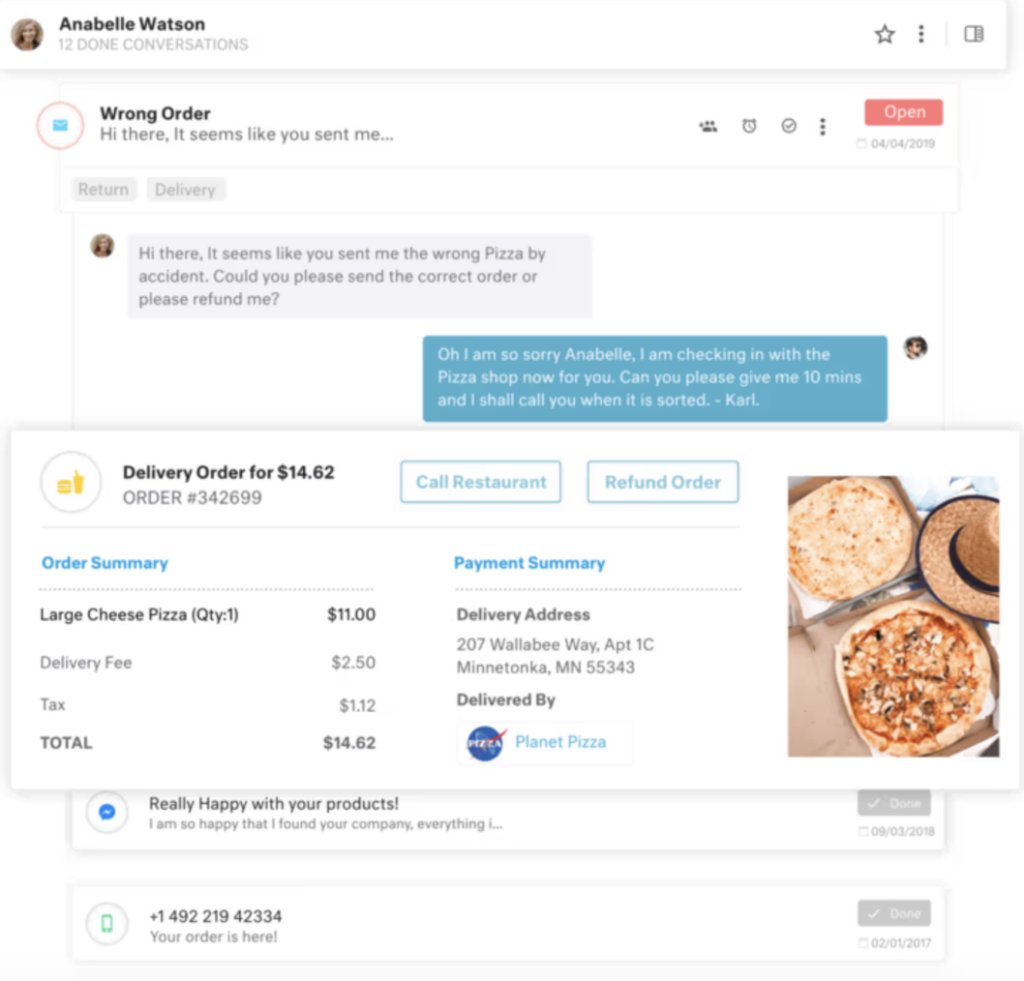
Key features
- Comprehensive Reporting and Analytics: Kustomer provides in-depth analytics and reporting tools that offer insights into key performance indicators (KPIs),customer satisfaction scores, and agent productivity.
- Omnichannel Support: Kustomer consolidates multiple communication channels—including email, chat, phone, SMS, and social media—into a single platform.
- Customizable Workflows: The platform offers flexible workflow customization, allowing businesses to tailor processes to their specific needs.
Reviews
“What I like best about Kustomer is the easy navigation of every conversation ticket, the side panel tools, plus the capabilty to use pre-made email macros for quick messaging to customers. Also, I like the real time customer satisfaction survey response.” (Kustomer User on G2)
“The down side of Kustomer is there is no AI technology built in. We do not have the ability to have automatic QA, which would be extremely useful. The Knowledge center is also very bland and there is no ability to customize it, only orgainze it.” (Kustomer User on G2)
Pricing
Kustomer’s pricing starts at $89 per user per month.
Free trial: 14 days
10. Gorgias
Gorgias is a help desk and digital customer support software specifically designed for eCommerce businesses. It enables online stores to manage and streamline their customer service operations by centralizing customer interactions from various channels into a single platform.
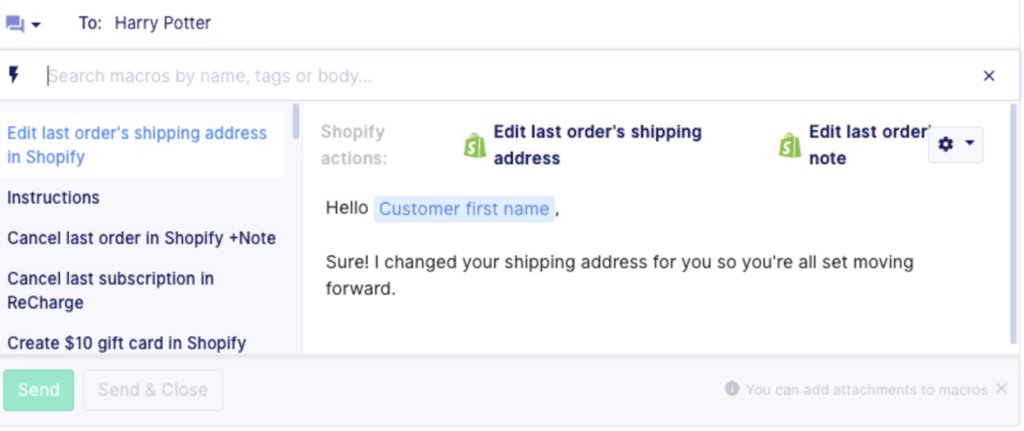
Key features
- eCommerce Integration: Gorgias integrates seamlessly with popular eCommerce platforms like Shopify, Magento, and BigCommerce. This integration allows support agents to view customer data, order histories, and other relevant information directly within the helpdesk, making it easier to provide personalized support.
- Macros and Templates: Gorgias allows teams to create and use pre-written responses (macros) and templates to quickly address common customer inquiries, improving efficiency and consistency in communication.
- Self-Service Options: Gorgias supports the creation of a self-service help center where customers can find answers to common questions without needing to contact support.
Reviews
“Its user-friendly features. Everything you need is just a click away, everything is right up front. No need to spend hours searching, if you need to create a view for tickets, it is the easiest thing!” (Gorgias User on G2)
“If you want to integrate ebay or amazon, you need a third party add on which is itself limited. Prepare for additional costs.” (Capterra)
Pricing
Gorgias’ plans start from $10 per month but with very limited functionality (includes 50 tickets per month + $0.40 for each ticket after that).
Free trial: 7 days
11. Happyfox
Happyfox is a cloud-based help desk and customer support platform that’s relatively easy to use. The software consolidates support requests from various channels – including email, phone, chat, and social media – into a unified system, enabling support teams to track, manage, and resolve them efficiently.
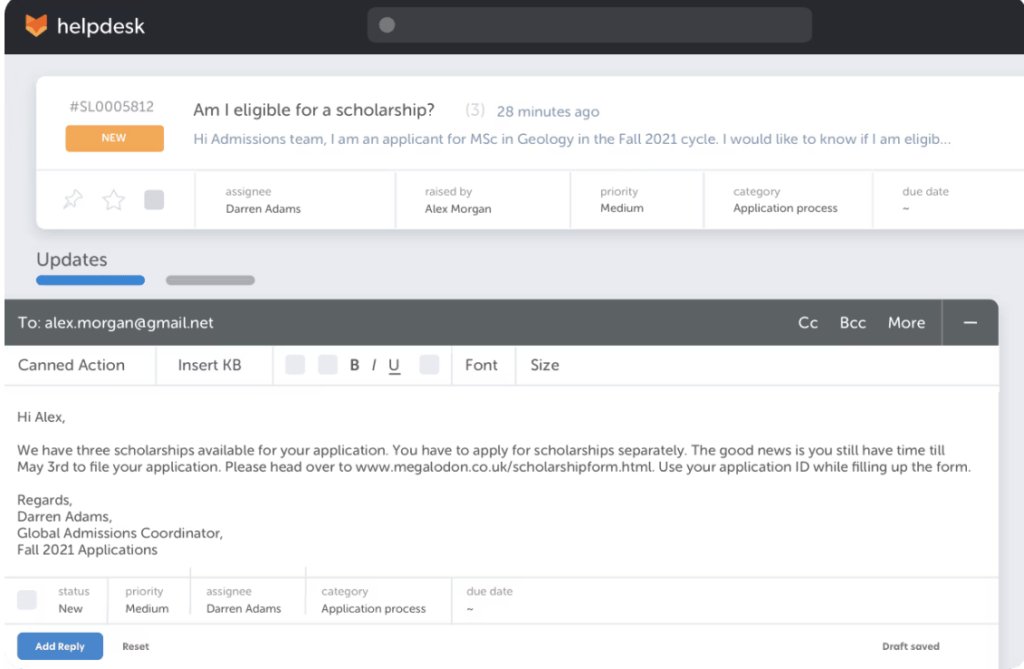
The software is trusted by over 2000 organizations across industries to streamline customer support operations as of today.
Key features
- Ticket Management: HappyFox helps organizations track, manage, and resolve customer support tickets from multiple channels, including email, social media, and chat.
- Reporting and Analytics: HappyFox offers robust reporting and analytics tools, providing insights into support team performance, customer satisfaction, and ticket resolution times.
- CSAT Surveys: Customer Satisfaction (CSAT) surveys can be sent automatically after a support interaction is completed. These surveys allow customers to rate their experience, providing valuable insights into how well the support team is performing.
Reviews
“I love how easy and intuitive their software is to set up and configure, including customizing the knowledge base.” (Happyfox User on G2)
“Can be sluggish load-time wise. There are some minor UI inconveniences at times, such as having to type in the ticket ID when relating two tickets vs being able to search by name and select that way.” (Capterra)
Pricing
Pricing starts at $9 per agent per month for teams looking for the bare essential features of a help desk. Happyfox’s most popular pricing plan that comes with advanced features like proactive agent collision and 24×7 email support costs $99 per agent per month.
Free trial: 14 days
12. Helpjuice
Helpjuice is a dedicated knowledge base platform suited for those organizations looking for a complete knowledge management solution either for their customers or for their internal team.
The software enables teams to create, organize, and share information effortlessly. It has an easy-to-use interface, robust customization options, and advanced analytics which come in handy for both use cases – to offer self support to customers or to boost employee productivity.
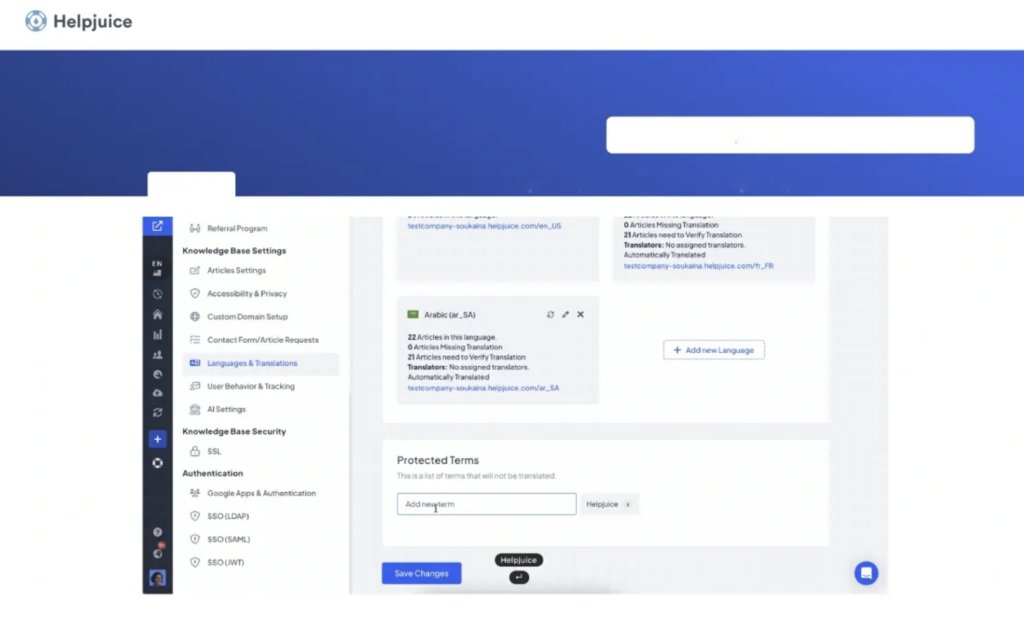
Key features
- Advanced Content Management: Helpjuice offers a powerful editor that supports rich text formatting, media embedding, and version control, enabling teams to create and manage articles efficiently.
- Customization and Branding: The platform provides extensive customization options, including multiple themes and a visual editor, allowing businesses to tailor the knowledge base to align with their brand identity.
- AI-Powered Search and Assistance: Helpjuice also incorporates AI-driven search capabilities, facilitating quick and accurate information retrieval.
Reviews
“We’ve been using HelpJuice for a couple of years now, and it has consistently exceeded our expectations. One of the standout features is the high level of customization—it allows you to structure articles in exactly the way you need, with a wide array of publishing options that cater to different needs.” (Helpjuice User on G2)
“As the company has grown, the response rate has become longer. Not a terrible thing, but when you’re used to someone getting back to you promptly and that changes, you notice. Also, they are starting to charge for customizations.” (Helpjuice User on G2)
Pricing
Helpjuice has one pricing plan for all it’s features – $120 per month for 4 users. It’s price increases with the increase in number of users. The tool offers a 14-day free trial.
13. Front
Front is a collaborative digital customer service platform that centralizes emails, chats, and messages from various digital channels into a single, unified inbox. Front’s interface is designed to be intuitive and familiar, resembling a traditional email client, which reduces the learning curve and allows teams to get up and running quickly.
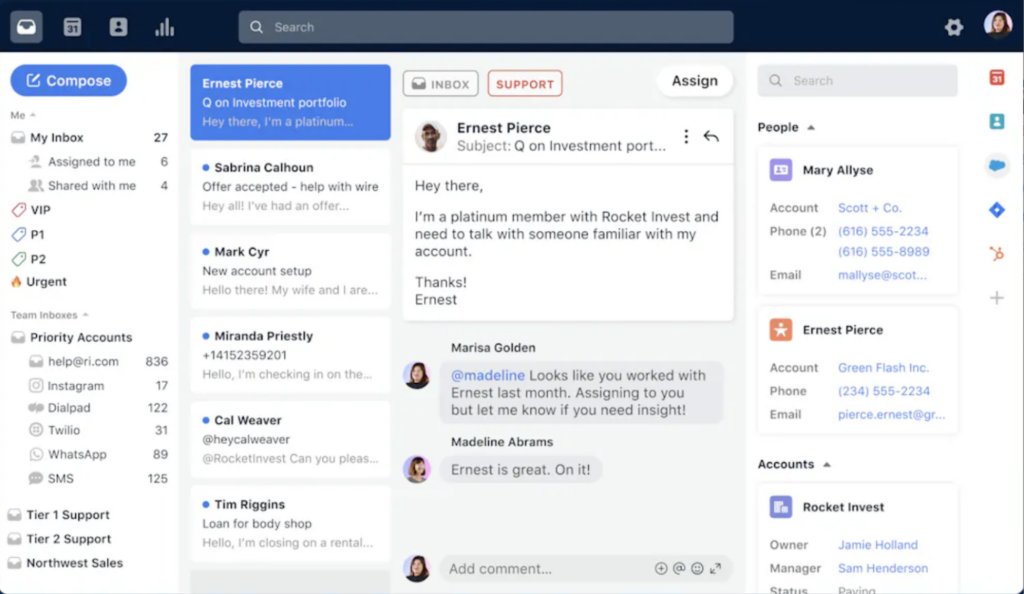
Key features
- Multi-Channel Communication: Front centralizes communication from various channels into a single, unified inbox. This enables teams to manage and respond to customer inquiries from different platforms without switching between tools.
- Collaboration: The platform allows team members to work in a collaborative way from their inboxes, sharing drafts, leaving comments, and assigning tasks to ensure that every customer query is handled promptly and accurately.
- Integrations with Third-Party Tools: Front integrates with a wide range of business applications, including CRM systems, project management tools, and chat apps.
Reviews
“Unlike Zendesk or similar products; emails you send from Front are actually sent from your email address, not a weird routing domain like yourcompany.zendesk.com.” (Capterra)
“The biggest issue we deal with is Front’s occasional latency. In an industry where fast is better than perfect, the last thing my team needs is Front to be lagging or down. We have a huge backlog of archived emails (Front also acts as customer documentation platform for us) so searching information can be super tedious if the platform doesn’t load or crashes.” (Capterra)
Pricing
Front’s pricing plans start from $19 per user per month for the most essential features and go up to $99 per user per month.
Free trial: 14 days
14. DevRev
DevRev is a modern customer relationship management (CRM) platform designed to bring customer support teams, development teams, and end-users together. It offers features like AI-powered ticketing, live chat, and seamless integration between support and product development.
Whether you’re running a startup or managing a large enterprise, DevRev provides tools to improve communication, boost efficiency, and offer unmatched customer service.
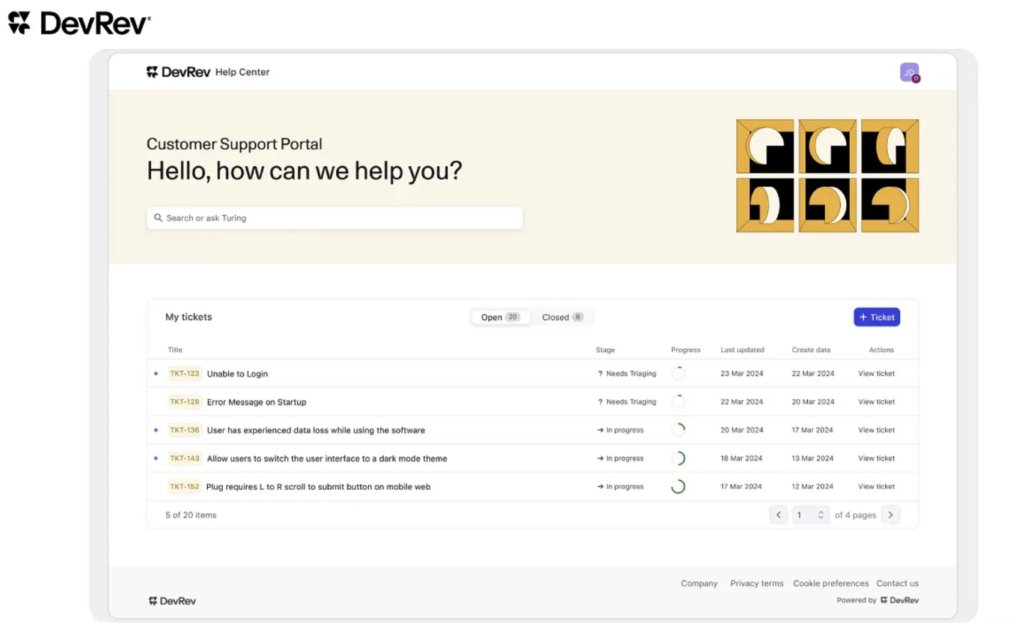
Key features
- AI-Powered Support and Automation: The platform leverages artificial intelligence to automate routine tasks, such as ticket routing and issue categorization. This automation streamlines support processes, allowing teams to focus on complex customer issues and improving overall efficiency.
- Unified Platform for Development and Customer Engagement: DevRev integrates development workflows with customer interactions, enabling seamless communication between developers and end-users.
Reviews
“We switched to DevRev recently (we used to work with Zendesk) to provide better service, tools, AI engines and overall experience to our clients, in addition to better analytics and AI tools for our Support agents. The integration phase and tools made the switch as easy as it gets, in addition to the DevRev team that planned and worked with us along the way.” (DevRev User on G2)
“While it integrates with many tools, setting up certain integrations can be complex and require more technical know-how than expected.” (DevRev User on G2)
Pricing
DevRev’s Pro Plan costs $34.99 per user per month for a support license.
Free trial: 45 days.
15. Kayako
Kayako facilitates customer interactions across various channels like email, live chat, and social media. It comes with over 600 integrations which lends it some added flexibility.
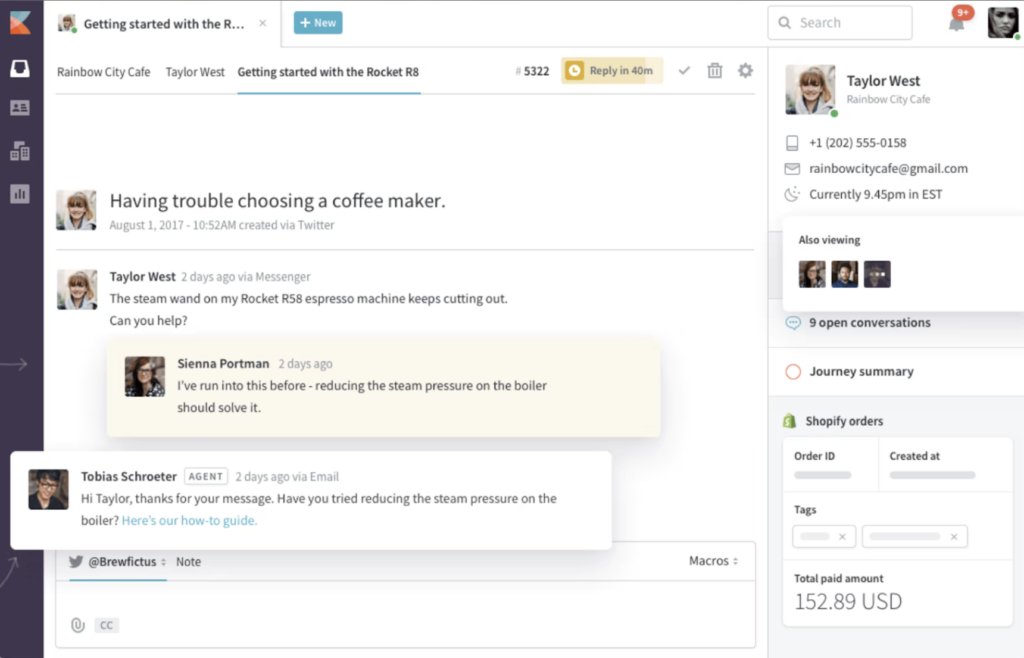
Key features
- Customer Journey Tracking: Kayako offers features that track the customer journey, giving support agents visibility into the customer’s past interactions, behavior, and preferences. This information helps agents deliver more personalized and context-aware support.
- Collaborative Support: Kayako supports team collaboration by allowing multiple agents to work together on resolving a ticket. Agents can leave internal notes, tag colleagues, and share information to ensure that complex issues are addressed effectively.
- Reporting & Analytics: The platform provides robust reporting and analytics tools that allow businesses to monitor and measure the performance of their customer support operations. Metrics such as response times, resolution times, and customer satisfaction can be tracked to identify areas for improvement.
Reviews
“The best feature of Kayako is that it allows you to organize your emails into folders based on departments, status and the nature of the email content.” (Capterra)
“The after-sale support is terrible. Once you sign up, that’s it, they will not answer any of your questions. Promise big and deliver nothing. Not walk the talk.” (Kayako User on G2)
Pricing
Kayako’s pricing starts at $39 per agent per month.
Free trial: 14 days.
16. LiveAgent
Live Agent is a complete customer support tool. It comes with a bunch of handy features such as ticketing system, call center, live chat, and social media integrations. Live Agent is also popular for its very quick set-up time. You can have the tool up and running in minutes.
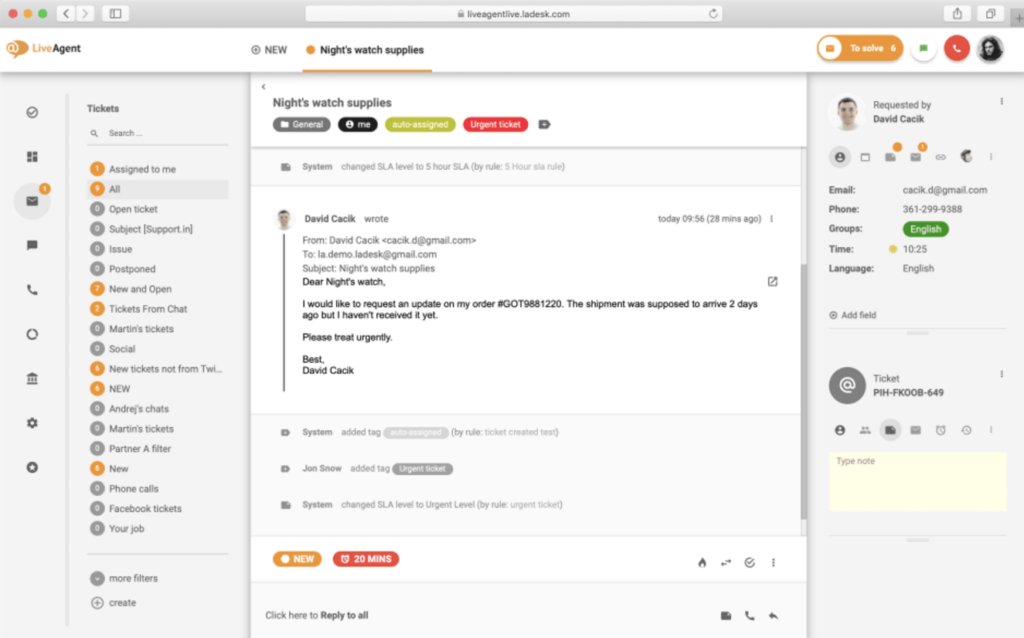
Key features
- Real-Time Live Chat: The platform offers a fast and customizable live chat widget, allowing businesses to engage with website visitors in real-time. Features like proactive chat invitations and real-time typing view enhance customer engagement and satisfaction.
- Integrated Call Center: LiveAgent includes built-in call center capabilities, enabling businesses to handle inbound and outbound calls directly from the platform. Features such as IVR (Interactive Voice Response),call routing, and unlimited call recordings facilitate efficient voice support operations.
Reviews
“Ticketing System is set out well and easy to use once you understand where to find things. Notes functions is great and it is useful each email has a ticket reference you can share with colleagues so they can quickly search and view the email. Dashboard insights are also great as you can see stats from your colleagues on what has been done in Live Agent.” (LiveAgent User on G2)
“Live Agent may sometimes take a while to pull emails through from outlook which can be inconvenient whilst on the phone to a customer.” (LiveAgent User on G2)
Pricing
Live Agent’s pricing plans start from $15 per agent per month.
Free trial: 30 days.
17. ProProfs Help Desk
ProProfs help desk offers a user-friendly trouble ticketing system that focuses on collaboration. It enables teams to streamline their support operations by keeping all aspects of ticket management in one centralized location.
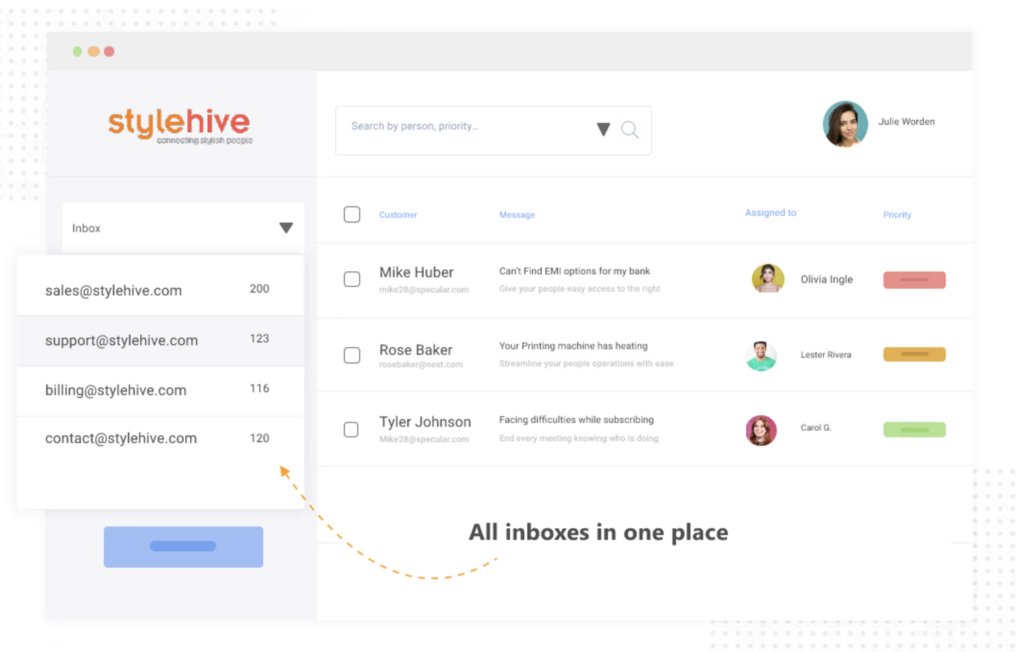
Key features
- Canned Responses: ProProfs Help Desk allows support agents to create and use pre-formatted replies for frequently asked questions. This feature reduces response time and maintains consistency in communication, enhancing the overall efficiency of the support team.
- Real-Time Chat Support: The platform integrates live chat functionality, enabling agents to engage with customers in real-time. This immediate interaction facilitates quick resolution of issues and improves customer satisfaction by providing instant support.
- Automated Ticket Assignment: The platform utilizes automation to assign tickets to appropriate agents based on predefined rules or a round-robin algorithm. This ensures balanced workloads among team members and accelerates the resolution process by directing issues to the most suitable personnel promptly.
Reviews
“The best part of being associated with ProProfs is that they offer incredible support. Unlike other help desk companies that reply on self-service or email, you can call their team anytime and have a meaningful interaction.” (ProProfs User on G2)
“I am not much impressed with their integration options to third-party tools. This is something that needs to be improved.” (ProProfs User on G2)
Pricing
ProProfs pricing plans start at $19.99 per user per month.
Free trial: 15 days.
18. HelpCrunch
HelpCrunch is an all-in-one customer communication platform designed to enhance support, marketing, and sales efforts.

Key features
- Advanced Customization and Branding: HelpCrunch provides extensive customization options for its chat widget and email templates, enabling businesses to align the appearance and behavior with their brand identity.
- Proactive Messaging and Auto Messages: The platform allows businesses to set up behavior-based auto messages that proactively engage website visitors or app users. These messages can be triggered by specific user actions, such as time spent on a page or exit intent, facilitating timely engagement and increasing conversion rates.
Reviews
“HelpCrunch works extremely well for small SaaS like us. We use it as a single customer communication tool that aligns chat on our website, chatbot, and help center. The most impressive aspect is that email and auto messages are included in our plan, allowing us to set up our transactional emails and onboarding using this platform.” (Helpcrunch User on G2)
“No dislike as such, but the reports on email campaigns could be improved. So far, they are not that intuitive to understand, and some metrics are hidden under “hover” options, like the time the campaign was sent.” (Helpcrunch User on G2)
Pricing
Pricing starts at $12 per user per month
Free trial: 14 days.
19. Tidio
Tidio is a customer service software that combines conversational AI with live chat. It aims to solve up to 70% of customer problems using conversational AI. The platform also offers real-time tracking of users across your website and provides dedicated helpdesk tools for managing all your chats.
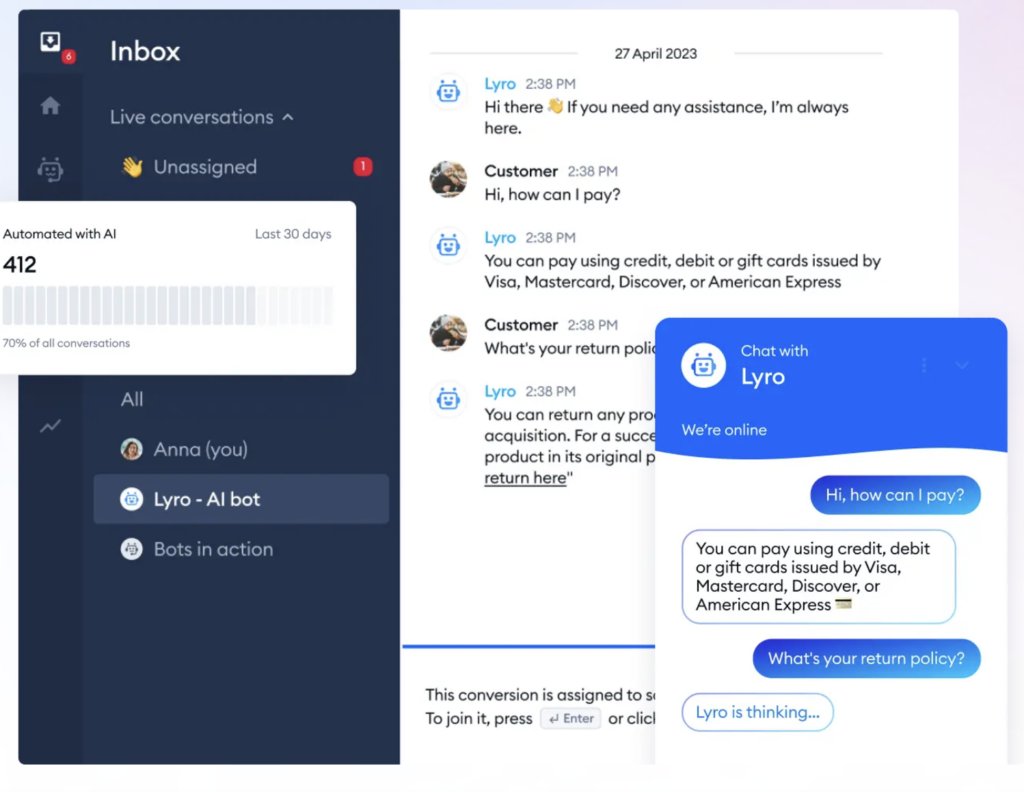
Key features
- AI Chatbots: Tidio’s AI, named Lyro, can answer common customer questions, freeing up your agents for more complex issues.
- Smart Views: The platform sorts conversations based on customer intent, helping you respond faster.
- Chat Templates: Engage website visitors with live chat and offer personalized discounts based on their activity. You can also use pre-defined chatbot templates to generate leads.
Reviews
“Tidio offers an intuitive interface that’s easy to navigate, making it simple to manage customer interactions. The chatbot feature is highly customizable and has significantly improved our response times. Integration with various platforms is seamless, ensuring we can maintain consistent communication across different channels.” (Tidio User on G2)
“The mobile app, though convenient, occasionally suffers from sync issues with the desktop version, which can cause missed messages or delayed notifications.” (Tidio User on G2)
Pricing
Tidio’s starter plan is priced at $29 per month for 100 live chat conversations.
How to select a helpdesk software that works for your business?
The biggest advantage of a customer service platform is that it helps streamline and organize customer requests at scale. It makes it possible for your support team to delegate these queries, collaborate faster, and build workflows that optimize their productivity.
In simpler terms, a customer service platform brings order to chaos.
Not all helpdesk solutions may fit your team’s requirements. But watch out for these red flags:
- Unnecessarily complicated plans and hidden charges
- Unresponsive customer support teams
- Complicated help documentation
- Overpromising sales reps relying only on the future potential of the product
- Lack of credible reviews/reference customers
These early warning signs signify serious problems at the vendor’s end. Steer clear.
Finally, ensure that you also take your team’s considerations into account. They’re the ones who’ll be using the tool on a daily basis.
Choosing the right software can be a daunting task. But when you make the process tangible and accountable, you can make better and more effective decisions.













